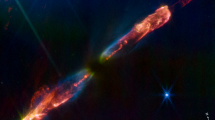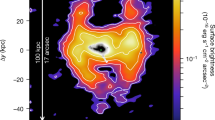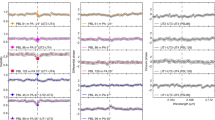Abstract
T Tauri stars are young stellar objects, similar in mass to the Sun, that are completing the transition between a collapsing cloud and a main-sequence star powered by hydrogen fusion1. Many of these objects are associated with circumstellar (and, presumably, protoplanetary) disks2, as well as energetic outflows of gas that can extend several light years away from the young star3. These outflows are thought to be collimated by magnetic fields4, but direct observational evidence for such fields has hitherto been lacking. Here we show that the infrared companion5 (T Tau S) of the prototypical T Tauri star (T Tau itself) recently ejected in opposite directions two large lobes of mildly relativistic particles. The radio emission from the two lobes exhibits strong circular polarization of opposite helicity, implying the existence of a strong, ordered magnetic field at a surprisingly large distance from the source. We also find that the T Tau system may contain three stars, rather than two as previously thought.
This is a preview of subscription content, access via your institution
Access options
Subscribe to this journal
Receive 51 print issues and online access
$199.00 per year
only $3.90 per issue
Buy this article
- Purchase on Springer Link
- Instant access to full article PDF
Prices may be subject to local taxes which are calculated during checkout
Similar content being viewed by others
References
Bertout, C. Annu. Rev. Astron. Astrophys. 27, 351–395 (1989).
Beckwith, S. V. W. & Sargent, A. I. Nature 383, 139–144 (1996).
Edwards, S., Ray, T. P. & Mundt, R. in Protostars and Planets III (eds Levy, E. & Lunine, J.) 567–602 (Univ. Arizona Press, Tucson, 1993).
Königl, A. & Ruden, S. P. in Protostars and Planets III (eds Levy, E. & Lunine, J.) 641–687 (Univ. Arizona Press, Tucson, 1993).
Dyck, H. M., Simon, T. & Zuckerman, B. Astrophys. J. 255, L103–L106 (1982).
Solf, J., Böhm, K. H. & Raga, A. C. Astrophys. J. 334, 229–251 (1988).
Böhm, K. H. & Solf, J. Astrophys. J. 430, 277–290 (1994).
Ghez, A. M. et al. Astron. J. 102, 2066–2072 (1991).
Ghez, A. M., Weinberger, A. J., Neugebauer, G., Matthews, K. & McCarthy, Jr. D. W. Astron. J. 110, 753–765 (1995).
Schwartz, P. R., Simon, T., Zuckerman, B. & Howell, R. R. Astrophys. J. 280, L23–L26 (1984).
Skinner, S. L. & Brown, A. Astron. J. 107, 1461–1468 (1994).
Philips, R. B., Lonsdale, C. J. & Feigelson, E. D. Astrophys. J. 403, L43–L46 (1993).
Nisenson, P., Stachnik, R. V., Karovska, M. & Noyes, R. Astrophys. J. 297, L17–L20 (1985).
Maihara, T. & Kataza, H. Astron. Astrophys. 249, 392–396 (1991).
Gorham, R. W. et al. Astron. J. 103, 953–959 (1992).
Schwartz, P. R., Simon, T. & Campbell, R. Astrophys. J. 303, 233–238 (1986).
Carlsberg Meridian Catalogue No. 4 (Copenhagen Univ. Observatory, Royal Greenwich Observatory, Real Institute y Observatorio de la Armada en San Fernando, 1989).
Kenyon, S. J., Dobrzycka, D. & Hartmann, L. Astron. J. 108, 1872–1880 (1994).
Skinner, S. L. Astrophys. J. 408, 660–667 (1993).
Dulk, G. A. Annu. Rev. Astron. Astrophys. 23, 169–224 (1985).
Guenther, E. W. & Emerson, J. P. Astron. Astrophys. 309, 777–780 (1996).
van Langvelde, H. J., van Dishoeck, E. F., van der Werf, P. P. & Blake, G. A. Astron. Astrophys. 287, L25–L28 (1994).
Roberto, M. et al. Astron. Astrophys. 296, 431–438 (1995).
Herbig, G. H. in Low Mass Star Formation and Pre-Main Sequence Objects (ed. Reipurth, B.) 233–246 (ESO Conf. and Workshop Proc. no. 33, ESO, Munich, 1989).
Curiel, S., Rodriguez, L. F., Moran, J. M. & Canto, J. Astrophys. J. 415, 191–203 (1993).
Author information
Authors and Affiliations
Rights and permissions
About this article
Cite this article
Ray, T., Muxlow, T., Axon, D. et al. Large-scale magnetic fields in the outflow from the young stellar object T Tauri S. Nature 385, 415–417 (1997). https://doi.org/10.1038/385415a0
Received:
Accepted:
Issue Date:
DOI: https://doi.org/10.1038/385415a0
This article is cited by
-
Modelling the Transition Layer of an Accretion Disk with a Burgers Vortex
Astrophysics (2017)
-
Self-organized electromagnetic field structures in laser-produced counter-streaming plasmas
Nature Physics (2012)
-
Experimental Design for the Laboratory Simulation of Magnetized Astrophysical Jets
Astrophysics and Space Science (2007)
-
Sheared Flow as a Stabilizing Mechanism in Astrophysical Jets
Astrophysics and Space Science (2007)
Comments
By submitting a comment you agree to abide by our Terms and Community Guidelines. If you find something abusive or that does not comply with our terms or guidelines please flag it as inappropriate.



